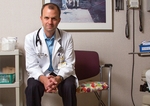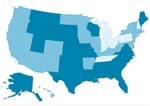Profession
Med schools respond to plea for more students
■ For the first time, the number of first-year students enrolling in allopathic medical schools tops 17,000.
- WITH THIS STORY:
- » Bigger student body
More doctors are in the pipeline.
Allopathic medical schools increased enrollment by 352 students, or 2.1%, in 2005-06, according to the Assn. of American Medical Colleges. This follows the AAMC's recommendation earlier this year that member schools boost enrollment by 15% over the next decade to help offset an anticipated physician shortage. The AAMC suggested that the expansion take place in areas where the nation's population is the fastest growing.
"The new data show this is indeed happening," said Jordan Cohen, MD, AAMC president. "We expect this to be just the beginning."
Dr. Cohen said expansion in states such as Florida and Texas was notable because the growing immigrant populations in those states was outpacing the supply of area physicians.
Until this fall, enrollment at allopathic medical schools was almost unchanged for the past 20 years. Osteopathic schools have been expanding rapidly, but their overall numbers are much smaller. For the 2005-06 academic year, there are 17,004 first-year students at allopathic medical schools. An estimated 3,889 first-year students enrolled in osteopathic schools.
AAMC officials are optimistic that member schools will reach the 15% target of 2,500 to 3,000 additional first-year students by 2015. But they acknowledge that reaching this goal could be difficult.
"Adding five, 10, 15 students is easier than 80 students," said Ed Salsberg, director of the AAMC's Center for Workforce Studies.
Based on AAMC surveys of medical school plans, Salsberg said he anticipates schools will be able to expand another 5% to 10% in the next few years. A 2003 survey of medical school deans showed that responding schools had the capacity to expand enrollment by 7.6%, said Richard Cooper, MD, a medical professor at Leonard Davis Institute of Health Economics at the University of Pennsylvania, who conducted the survey.
To grow larger likely would require building new medical schools. That is costly, but the option is being discussed around the nation, Salsberg said. "I suspect we'll see some new schools over the next several years."
Residency slots must expand, too
Of course, more medical school graduates will mean a need for more residency positions.
The AAMC advocates lifting the Medicare spending cap on graduate medical education so that resident positions can increase as med school enrollment rises.
Though the government has not increased GME spending, Salsberg said that mounting pressure for more physicians has teaching hospitals squeezing their budgets to gain modest expansions in resident positions.
"Despite the Balanced Budget Act, America's teaching hospitals over the last eight years have been training more physicians," Salsberg said. "We don't know if they will be able to continue to absorb the increase [in U.S. medical students], but so far they have. And we've not noticed any crowding out of international medical graduates."
Salsberg pegged the growth in graduate medical education at about 3% between 1997 and 2004. During the 2004-05 academic year, there were 101,810 medical residents; roughly 25% of them are IMGs.
The American Medical Association recognizes existing shortages of physicians in many specialties and areas of the United States. The AMA supports efforts to quantify these shortages and current programs to alleviate the shortages.
Estimates of an impending physician shortage vary. One forecast by Dr. Cooper projects a 200,000-physician-shortage by 2020. A study Salsberg conducted for the Council of Graduate Medical Education expects an 85,000-physician shortfall by 2020.












